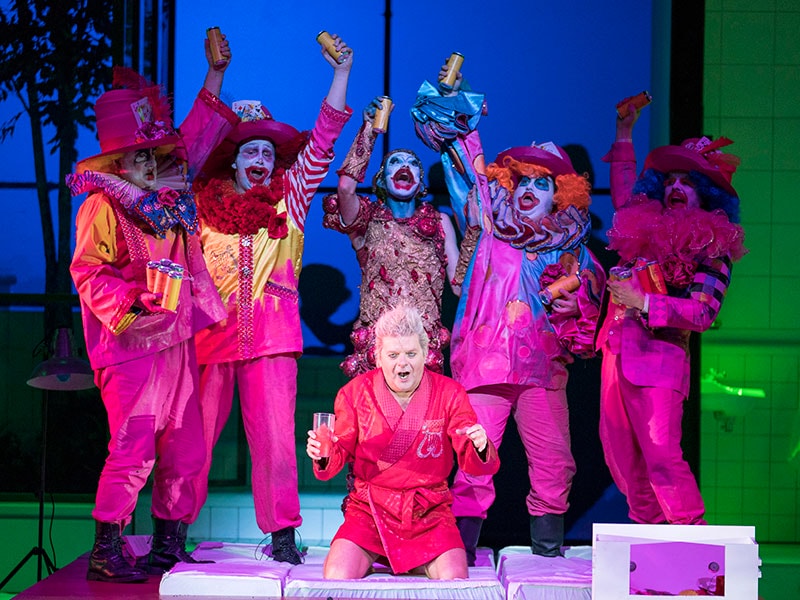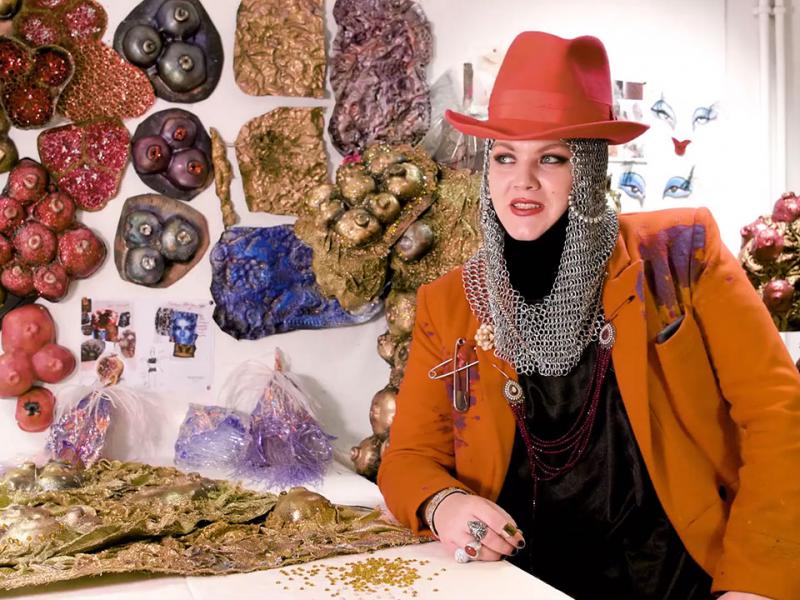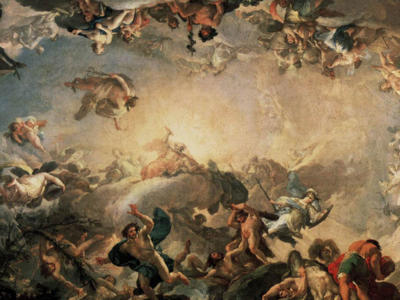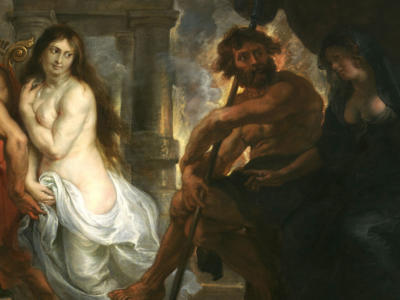Discover The Mask of Orpheus
Receiving its first full staging in London since its 1986 premiere at the London Coliseum, The Mask of Orpheus is Birtwistle‘s complex retelling of the Orpheus myth.
Scored for massive orchestral forces, The Mask of Orpheus, explores the contradictions in the various versions of the famous Greek tragedy, building a three-dimensional picture that leads us from inconsolable grief to acceptance and transformation.
Synopsis
Parodos
Apollo presides at the birth of Orpheus and gives him the gifts of speech, poetry and music. Orpheus’ first memory is of his heroic voyage on the Argo with Jason and his men.
Act I
Scene 1
Orpheus falls in love with Eurydice. She agrees to marry him
*First Passing Cloud: The Myth of Dionysus. The Titans captured Dionysus, who tried in vain to escape by assuming the form of a bull, a snake and a lion. Although they killed him, Rhea, his grandmother, reconstituted him and brought him up as a woman. He discovered wine and its effects.
In the wedding ceremony, Hymen (God of Marriage) is invoked and the priests ask ritual questions; but there are bad omens: Hymen arrives late and Eurydice stumbles repeatedly over her answers in the ritual. Not even Orpheus can dispel this atmosphere with his love-song for Eurydice.
Scene 2
Two versions of the death of Eurydice are presented simultaneously. Eurydice wanders by the river.
Second Passing Cloud: The Myth of Lycurgus. Lycurgus and his men fought Dionysus and captured his followers. Rhea released them and made Lycurgus so mad that he killed his own son thinking he was pruning a vine. The earth turned barren at the crime. Dionysus returned and Lycurgus, taken by his people to a mountain, was torn apart by wild horses.
Aristaeus, Man and Hero, make love at the same time to Eurydice, Woman and Heroine. In one case she resists and in the other she does not. In both versions she dies from the bite of a water-snake.
*First Allegorical Flower: The Myth of the Anemone. Venus loved the beautiful Adonis. Despite her warnings, he hunted wild boar and was fatally wounded in the genitals. Brought by her swans to his side, she could not save him but, in sorrow, she decreed that every year his death should be commemorated. From his blood sprang the anemone, a flower whose petals fall quickly in the wind.
Aristaeus tells Orpheus of Eurydice’s death.
Scene 3
First time distortion: Orpheus imagines it was he, not Aristaeus, who saw Eurydice die.
There are echoes of the love duet during Eurydice’s funeral ceremony, and the priests invoke Hermes, who, it is hoped, will guide her to the Underworld. They enact a ritual of the Tree of Life. Orpheus is unable to accept that he was powerless to save his wife. He leaves the ceremony to consult the Oracle of the Dead.
The Oracles envies his magic and gives him three clues to the Underworld in exchange for his magical power of music: ‘Always face the way of the sun’; ‘Choose without choosing’; ‘Never address anyone directly’. But when the Oracle tries to copy Orpheus’ song, all she can manage is hysterical screeching.
Orpheus imagines he can find his way to the Underworld. He describes the 17 arches of the aqueduct that connects the world of the living to that of the dead. Eurydice is transformed into myth.
Act II
Second time distortion: another version of Eurydice’s death, in which she is killed by a giant snake.
Orpheus Man, exhausted, has a deep and terrible sleep, in which he dreams that he, as Orpheus Hero, descends through the arches into the Underworld. All the figures he confronts are grotesque versions of the characters he has encountered in the first act. As the Oracle instructed, he walks backwards, always facing the sun he is leaving behind; during his descent there are many obstacles because it is forbidden for the living to enter the Underworld.
Scene 1: The Descent
Arch 1: Countryside. Orpheus sings to Charon and crosses the River Styx.
Arch 2: Crowds. Orpheus’ music brings tears, for the first time, to the eyes of the Furies.
Arch 3: Evening. The Judges of the Dead foretell Orpheus’ death. He sees a vision of Eurydice.
Arch 4: Contrasts. Orpheus drinks from the pool of memory but refuses to drink from the pool of forgetfulness. He has a second vision of Eurydice.
Arch 5: Dying. Orpheus sees those in torment as he passes.
Arch 6: Wings. His magic overcomes even the fiercest of the characters in the Underworld.
Arch 7: Colour. At last Orpheus reaches the centre of the Underworld and stands before its rulers: Hades, his wife Persephone, and Hecate. He fails to see their resemblance to himself, Eurydice or the Oracle.
Arch 8: Secrecy. Orpheus continues to sing.
Arch 9: Glass. He makes his escape.
Scene 2: The Return
Arch 10: Buildings. He is surrounded by wispy shadows resembling Eurydice.
Arch 11: Weather. Although Eurydice shadows dance around him, he makes no choice.
Arch 12: Eyes. Orpheus begins his return, imagining that the real Eurydice is following him, but it is Persephone.
Arch 13: Knives. Persephone stumbles and another Eurydice takes her place. Orpheus overcomes the same obstacles as on his descent: in turn they utter screams and disappear. Eurydice tries to follow but the dead cannot leave the Underworld. One form of Euridice takes the place of another. As Orpheus journeys, he hears Apollo’s voice in his head urging him to sing.
Arch 14: Animals. Orpheus crosses the River Styx. Charon refuses to take Eurydice and she falls back. As Orpheus emerges into the sunlight, he awakes. Eurydice is already fading from his memory.
Arch 15: Ropes. Orpheus has lost Eurydice for ever.
Arch 16: Order. Orpheus realises his journey was a dream and re-enacts it as Orpheus Hero.
Arch 17: Fear. Orpheus mourns Eurydice and rejects the three women who offer to marry him.
Second Allegorical Flower: The Myth of the Hyacinth. Apollo and the youth Hyacinth competed at the discus. Apollo’s returning discus killed Hyacinth and the god could not save him. He changed him into a flower, with the mournful Greek characters, ‘Ai-Ai’ upon its petals.
Orpheus is so desolate that he hangs himself.
Act III
The structure of the act is based on the movement of tides on an imaginary beach. Nine episodes of the myth are presented in an artificial time-sequence, which starts by receding into the past, then comes forward into the future and finally begins to return to the past. Between these episodes, Orpheus sings the verses of his ‘Song of Magic’, eventually challenging Apollo.
Third time distortion: Orpheus Hero is rejected by the Underworld and is re-born as a myth.
Episode 1
Orpheus Hero re-enacts his journey out of the Underworld with Eurydice. She dies and he hangs himself.
Episode 2
Orpheus Man sings of his imaginary descent to the Underworld.
Episode 3
The death of Eurydice is seen again but this time observed by Orpheus Man and Hero, instead of Aristaeus.
Second Allegorical Flower: The Myth of the Lotus. Beautiful Dryope was suckling her child by a pool. When she plucked a lotus flower, to her horror she found drops of blood upon her hand. She did not know that the nymph, Lotus, had been changed into the flower to escape the lust of Pryapus. She too became a lotus tree. Her husband and father protected the tree from animals and allowed her son to play in the shade of what had been his mother.
Orpheus remembers his imaginary ascent from the Underworld.
Episode 4
Orpheus Hero re-enacts his journey out of the Underworld with Eurydice. She dies and he hangs himself.
Episode 5
Aristaeus is punished by his bees. Orpheus consoles him. But Zeus is angered by Orpheus’ presumption in revealing divine mysteries in his arcane poetry and music, and strikes him dead with a thunderbolt.
Episode 6
Orpheus Myth is sacrificed and dismembered by the Dionysiac women. His head is thrown into the River Hebrus.
Episode 7
The head of Orpheus floats down the river. He still murmurs piteously. Orpheus challenges the sun-god with his song.
Episode 8
Orpheus Myth has become an oracle and is consulted by Aristaeus. A snake, which tries to silence the oracle, is killed by Apollo. But the god himself finally silences Orpheus for rivalling his own oracle at Delphi.
Third Passing Cloud: The Myth of Pentheus. Dionysus dressed Pentheus as a woman so that he could penetrate secretly into the Dionysiac women’s revels. He tried to stop them tearing a bull apart with their bare hands, and instead, in their frenzy, they tore him apart. His own mother ripped off his head.
Episode 9
The sacrifice of Orpheus Myth is continued as if the two previous episodes had not happened. The Dionysiac women eat his flesh.
Exodos
The myth of Orpheus decays.
*The ‘Passing Clouds of Abandon’ and ‘Allegorical Flowers of Reason’: six other myths related to Dionysus and metamorphosis interrupt the main Orpheus myth at moments of calm and crisis.







